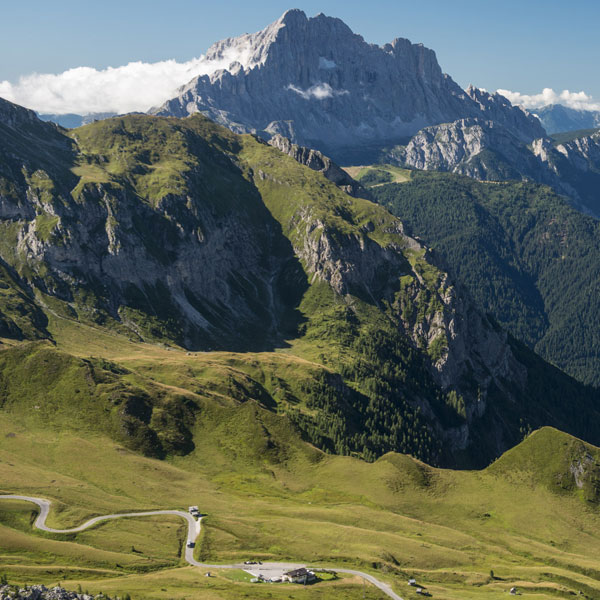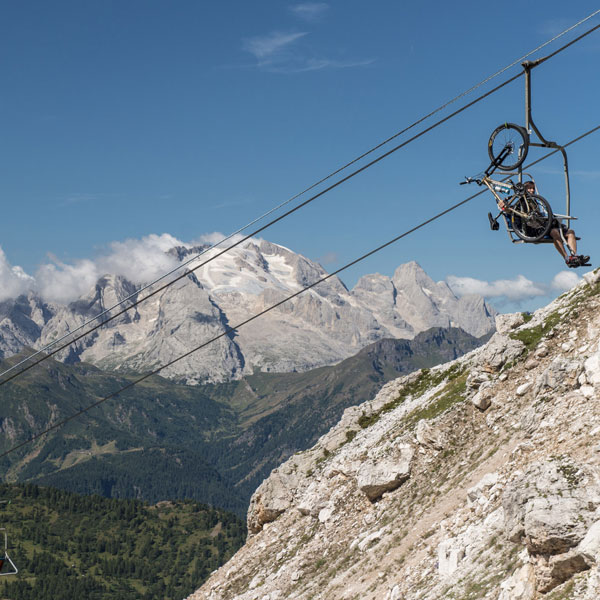
- Home
- Le 5 Torri
- Current: Geology
Geology
The Main Dolomite, a well-stratified limestone, characterizes the Cinque Torri and many mountains of the Dolomites.
The particular formation of these five towers is due to the combined effect of several factors, the most important of which is tectonics, which displaces parts of the Earth's mantle and generates faults.
It was the vertical faults in the rock strata that caused the formation of the "towers". The irregular overlap formed a sort of "staircase formation", which has lowered some sectors and raised others. The Averau massif, for example, is geographically higher than the Cinque Torri, as it is resting on a higher step.

The Cinque Torri: a privileged viewpoint
The difference in consistency and resistance between the rock texture of the Cinque Torri and the more fragile rock beneath is the reason for the precarious equilibrium of the towers. This is not only due to the kind of rock but is also caused by tectonics, erosion and, above all, frost weathering, a process that fractures the rock as a consequence of thermal stress.
From this privileged vantage point, you can observe many peculiarities of the Dolomites. The valleys and rock walls facing the Cinque Torri rest on substantial fractures: the main fault lines.
The crags, peaks and numerous pinnacles that immediately catch the eye are due to the different reactions to erosion of the rock. The dolomite stone forms imposing pinnacles, peaks and walls, whereas the grassland areas arise from the modelling of clay and marl.

The glacier and the rock glaciers
The landscape of these mountains is also visibly marked by the movement of the glaciers, which involved the Dolomite valleys several times in the last Alpine glaciation, leaving unequivocal traces.
The glacial cirques, moraines or glaciers still present today bear witness to these glacier movements.
Among these, from the Giau Pass, the Averau Pass or from the Nuvolau you can easily admire the Marmolada Glacier, a residual Würmian ice cap.
The Ice Age past has also deposited numerous glacial erratics. One of these can be seen on the way from the Giau Pass to the Scoiattoli Refuge. Hard to miss, considering its gigantic proportions!

The Rock Glacier of Mt. Averau
Climate change and the resulting changes in weather conditions accelerate the modeling processes caused by ice, as it creates extensive scree and boulders. These can be clearly seen, for example, on the slopes of the mountains Lagazuoi, Tofane and Averau mountains.
During the ascent with the Fedare chairlift, the rock glacier of the Averau on the left side catches the eye with its particular shape. This type of glacier arises from a periglacial process associated with cold climates and frozen ground.
Owing to the freezing and thawing processes or by deformation of the ice contained in the debris, these glaciers move along the slopes, displacing large amounts of debris and assuming shapes similar to those of a real glacier.
IMPIANTI AVERAU S.r.l.
Via del Mercato, 14
I-32043 Cortina d'Ampezzo - BL
T. +39 0436 4010: chair lift
T. +39 0436 871178: office
C.F. e P.I. 00166150250
IMPIANTI AVERAU S.r.l.
Via del Mercato, 14
I-32043 Cortina d'Ampezzo - BL
T. +39 0436 4010: chair lift
T. +39 0436 871178: office
C.F. e P.I. 00166150250
Contacts
E-mail: seggiovia@5torri.it
Privacy Policy
Change your preferences
Privacy Policy
PRIVACY POLICY IN ACCORDANCE WITH ARTICLES 13, 14 OF THE GDPR (GENERAL DATA PROTECTION REGULATION) 2016/679
In compliance with the GDPR, your personal data will be processed according to the principles of fairness, lawfulness, transparency, and protection of your privacy and individual rights.
Holder and Controller of Personal Data Processing:
Holder of Personal Data Processing is Impianti Averau S.r.l.
located at 14, via del Mercato– 32043 Cortina d'Ampezzo
What data we collect
In order to use some type of services sometimes you may be asked to provide some personal data, i.e. first name and email address
Purposes of Personal Data Processing. Why we collect your data.
Direct Marketing activities: we utilize your email address to deliver information on our initiatives and cultural activities.
Legal Basis for the Processing of your Personal Data
Impianti Averau S.r.l. will require your consent before processing your personal data for direct marketing purposes.
Sharing and Disclosing Personal Information
On our website there are forms to contact some accommodation facilities in order to obtain information or book services. In this case you will be asked for the name and contact details that are necessary to manage your request and therefore will be transmitted to the owner of the accommodation.
Protection of personal data. Processing Methods
We have implemented adequate and suitable technical and organizational measures to safeguard and protect your personal data.
Such measures take into consideration the state-of-the-art of the IT system/environment, implementation costs, the nature of personal data, and the risks around processing personal data. The purpose is to protect your personal data against accidental or unlawful damage, destruction, or loss, unauthorized disclosure or access, and other forms of unlawful processing.
Besides the Holder, under some circumstances, third party entities may have access to your personal data, either internally when involved in the development of our website (administration, marketing, legal entities or service providers) or externally (third party providers of technical services, hosting provider). Whenever needed, the Holder will name these entities as Controllers.
Storage of Personal Data
Since your personal data is collected with your consent, it will be retained as long as you withdraw your consent to processing. You may withdraw your consent at any time. (See below the "Your Rights" chapter)
Your Rights
The GDPR provides the following rights for data subjects:
- The right to rectification: you may require the Controller to rectify any errors in your personal data.
- The right to restrict processing: you may require a restriction of personal data processing when you contest the accuracy of your personal data, or in case of unlawful processing, or if you object to the processing.
- The right of access: at any time and free of charge you may require the Controller to provide information on your personal data (concerning you), including information on the categories of personal data concerned, the purposes of our processing, and the possible recipients we may have disclosed your personal data.
- The right to data portability: you may require the controller to transmit your personal data to another controller, if this is technically feasible and provided that the processing of your personal data is based on your consent or is necessary for the performance of a contract.
- The right to erasure: you may require the controller to delete your data when:
a) personal data is no longer necessary for the purpose for which it was originally collected or processed;
b) you withdraw consent to processing;
c) you object to processing and there is no overriding legitimate grounds for continuing the processing;
d) the data have been processed unlawfully
The right to erasure will not apply if the processing is necessary to comply with a legal obligation or for the establishment, exercise or defence of legal claims.
- The right to object: at any time you may object to the processing of your personal data for direct marketing purposes. In this case your personal data will no longer be processed for these purposes. Should you decide to exercise this right, please let us know whether you mean/want to delete your personal data or restrict their processing.
You may exercises these rights or obtain further information by emailing: seggiovia@5torri.it
Use of cookies and log files
Information on Cookies
This website makes use of cookies. Below you will find further information on cookies, how they are used in this website and the control procedures we use with regard to the cookies.
If you continue browsing this website you are consenting to the use of cookies, in accordance with the terms of this policy. The type of cookies used in this website does not require previous consent by the users.
About cookies
Cookies are small files of data that a website asks your browser to store on your computer or mobile device. Cookies may then be sent back to the server each time the browser requests a page from the server or may be sent to a different website able to recognize that specific cookie. The cookie allows the website to "remember" your device every time you return to that website.
Types of cookies in this website
A session cookie is used for a single session and will expire at the end of the browser session, when the web browser is closed. These technical cookies do not require the user's consent prior to their use.
This website also uses third party technical cookies like the ones provide by Google Analytics and You Tube.
Google Analytics is an Analysis Tool provided by Google which utilises performance cookies to collect anonymous navigation data (IP truncated at the last octet) and aggregate information to measure how users interact with the website content, to create reports on users' activities in the website and provide further information, such as the number of visitors and the pages they have visited.
Google may also transmit this information to third parties when required by legal obligations or when third parties process this data on behalf of Google. Google will not associate your Ip address to any other data in their possession. Personal data provided to Google are stored on Google servers in the US.
In compliance with the specific agreement with Google, designated as controller of personal data processing, Google is committed to process this data in compliance with the Holder's requirements (see below) given by the software settings. Based on the settings, advertising and sharing options are disabled.
For further information on Google Analytics Cookie Usage visit: Google Analytics Cookie Usage on Websites.
Users may selectively disable data collection from Google Analytics by installing the opting out tool provided by Google on their browsers.
YouTube is a platform for video sharing owned by Google that uses cookies to collect information about users' activities and navigation devices. Videos on this website do not carry cookies to access the page because the "no cookie policy" has been set, according to which YouTube does not record users' personal data unless they voluntarily choose to play the videos.
For further information on personal data usage and processing by Google, we recommend reading the information on the dedicated page prepared by Google and the page on How Google uses information from websites or apps that use their services.
How to control and delete cookies
Most web browsers support cookies, but users can change the settings of their browser to decline them, delete the existing ones or simply be informed when a new cookie is sent to their device.
To set their browsers to decline cookies, users can refer to the directions given by the browser provider (usually in the menu “Help”, “Tools” or “Modify”). The following link contains a more detailed guide about cookies: www.aboutcookies.org

